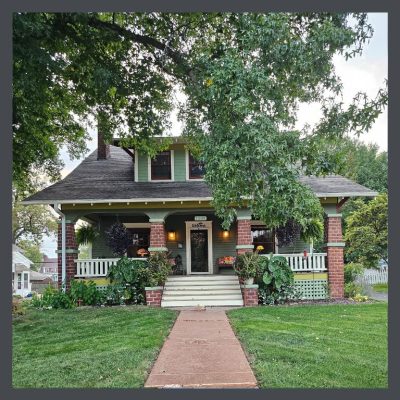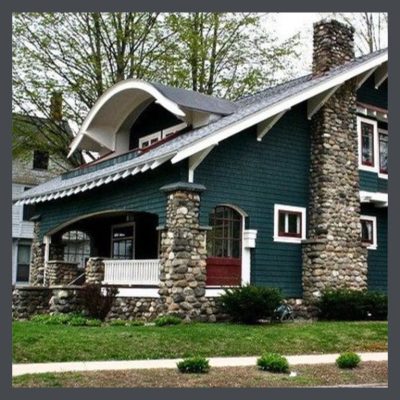 Frère Jacques,
Frère Jacques,
Frère Jacques,
Dormez-vous,
Dormez-vous?
This childhood ditty expresses the origin of the architectural term, dormer- late 16th century (denoting the window of a dormitory or bedroom): from Old French dormeor ‘dormitory’, from dormir ‘to sleep’.
Let’s talk about this architectural, bungalow feature that is as charming as the little song. Perched atop a sloping roof, a dormer has 2 parts. The first part is a vertical window, usually sash or casement, bringing light & air into the room. The second is a roof which may be gabled, hipped, eyebrow or shed.
Typically, the type of roofing material on the larger, main roof is duplicated on the smaller dormer roof. Dormers are generally finished with the same architectural elements as the rest of the roof line.
Like chimneys, the base of the dormer penetrates the main roof. Flashing is a flat, thin piece of metal (most popularly steel) that is used in the construction of the roof to help waterproof any intersections or protrusions, such as a chimney or a dormer. It helps to direct water away from the seams & joints, & down, off the roof, preventing it from entering the structure. Unfortunately, even with flashing, a roof with a dormer protruding through it is more susceptible to leaking.
TYPES OF BUNGALOW DORMERS
 HIPPED DORMER
HIPPED DORMER
On a hipped dormer, the roof slants back as it rises, and this occurs on the front as well as on the sides. This means that the hip roof of the dormer slopes upward on all 3 sides of its structure.
One good thing about this dormer is that it has eaves all around it, so its walls & windows are protected from severe weather conditions. The eaves also provide shade in the summer, a good feature in an upper story, & an energy saving feature.
Another big advantage is its wind resistance. I live in Florida. We love wind resistance!
Hipped dormers, not surprisingly, are often found on houses where the main roof is hipped as well, such as this one.
 GABLE DORMER
GABLE DORMER
A gable is the triangular area of a wall under two intersecting roof pitches. Not surprisingly, a gable dormer is the same triangular peaked shape & its steep sides are very good at shedding water & snow.
It is the type most usually seen on any style of house & are often used on bungalows. They add the greatest amount of headroom & can be used effectively in multiples, marching across a roof. A single gable dormer can hold one or several windows, depending on its size.
A gable dormer can even be a clipped or jerkinhead gable.
Meanwhile, here’s a good example of a gable dormer with multiple windows.
 SHED DORMER
SHED DORMER
In contrast to a peaked gable, shed dormers are often horizontally proportioned & do not draw attention to themselves like the more showy gable dormers. They are easy to recognize by their single-slope, or monopitch, roofs.
A shed dormer can cover extensive portions of the roof, sometimes almost the full expanse of the house, creating a large, usable space. The larger ones can hold several windows but they can be smaller, holding only a single window.
Visually, a shed former breaks up a tall, sloping roof line, drawing attention to the door & windows. It’s an opportunity to add color on a house with a deep porch which might have windows that are obscured by shade. The highly visible dormer windows of this house clearly display the beautiful palette chosen by the owner of this meticulously restored bungalow in Mexico, Missouri.
 EYEBROW DORMER
EYEBROW DORMER
This charming detail, not surprisingly, harkens back to the Middle Ages, before glass was used in windows, when metal or wooden posts were used, thus allowing light & air into the space while providing some protection from the elements.
The dormer appears to roll up from the roof, requiring shingles that are flexible such as cedar shingles, slate, clay tiles & even small-diameter split logs.
You see eyebrows not just in dormers, but also over entries where they provide shelter, & above windows on upper stories of buildings.
In the hundreds of miles of bungalow gazing I have done, I have been unable to find & photograph a single eyebrow dormer. Ple-e-e-ase if you have such a photo that you would allow me to use, I would love to hear from you. I am also very curious as to where they might be found in the U.S. They are scarce as hen’s teeth in Tampa Bay.
CHICAGO BUNGALOW DORMERS
 You gotta love a Chicago bungalow (You can read more about them here.) & they don’t let us down when it comes to dormers. For the houses there, being built on narrow lots, dormers are the obvious way to add extra space. Many bungalows in Chicago were constructed with them & a number of dormers have been added on over the past 100 years.
You gotta love a Chicago bungalow (You can read more about them here.) & they don’t let us down when it comes to dormers. For the houses there, being built on narrow lots, dormers are the obvious way to add extra space. Many bungalows in Chicago were constructed with them & a number of dormers have been added on over the past 100 years.
These delightful drawings are the work of Wonder City Studio, a pair of talented artists who admire & have a profound understanding of old houses & love Chicago. On the left we have an interrupted front gable dormer or a classical pediment. The triangle on top is visually set apart from the area below by the horizontal beam, forming a pediment. The one in the center is a complete mystery to me & I am hoping that my friend Jo-Anne will help me out. The one on the right is a hipped dormer, sitting on a main roof that is also hipped. It is really cool how this bungalow shows so many angles & shapes.
When you look at a Chicago streetscape, you see a neat row of unique homes with dormers of different shapes.
I recommend that you read Jo-Anne’s article WHAT THE HECK IS A BUNGALOW ANYWAY? so you can get a good idea of what these dormers sit on!
STAY IN THE BUNGALOW KNOW!!!
Sign up for our newsletter & receive our FREE E-book, 7 VITAL Things to Do Before You Hire a Contractor.




Really love this article! I love all the structural details of the houses and that they all have names! I also love drawing them!
Thank you for the nice article!
How wonderful of you to tell me this! You are very welcome.
I have zero ability when it comes to drawing. I envy you greatly!